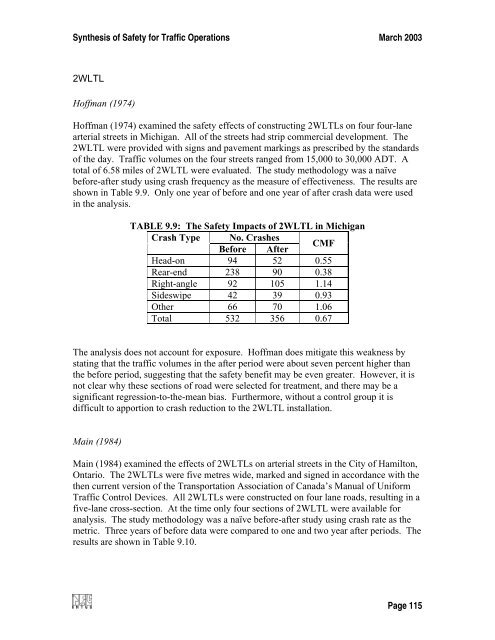Synthesis of Safety for Traffic Operations - Transports Canada
Synthesis of Safety for Traffic Operations - Transports Canada
Synthesis of Safety for Traffic Operations - Transports Canada
You also want an ePaper? Increase the reach of your titles
YUMPU automatically turns print PDFs into web optimized ePapers that Google loves.
<strong>Synthesis</strong> <strong>of</strong> <strong>Safety</strong> <strong>for</strong> <strong>Traffic</strong> <strong>Operations</strong> March 2003<br />
2WLTL<br />
H<strong>of</strong>fman (1974)<br />
H<strong>of</strong>fman (1974) examined the safety effects <strong>of</strong> constructing 2WLTLs on four four-lane<br />
arterial streets in Michigan. All <strong>of</strong> the streets had strip commercial development. The<br />
2WLTL were provided with signs and pavement markings as prescribed by the standards<br />
<strong>of</strong> the day. <strong>Traffic</strong> volumes on the four streets ranged from 15,000 to 30,000 ADT. A<br />
total <strong>of</strong> 6.58 miles <strong>of</strong> 2WLTL were evaluated. The study methodology was a naïve<br />
be<strong>for</strong>e-after study using crash frequency as the measure <strong>of</strong> effectiveness. The results are<br />
shown in Table 9.9. Only one year <strong>of</strong> be<strong>for</strong>e and one year <strong>of</strong> after crash data were used<br />
in the analysis.<br />
TABLE 9.9: The <strong>Safety</strong> Impacts <strong>of</strong> 2WLTL in Michigan<br />
Crash Type No. Crashes<br />
Be<strong>for</strong>e After<br />
CMF<br />
Head-on 94 52 0.55<br />
Rear-end 238 90 0.38<br />
Right-angle 92 105 1.14<br />
Sideswipe 42 39 0.93<br />
Other 66 70 1.06<br />
Total 532 356 0.67<br />
The analysis does not account <strong>for</strong> exposure. H<strong>of</strong>fman does mitigate this weakness by<br />
stating that the traffic volumes in the after period were about seven percent higher than<br />
the be<strong>for</strong>e period, suggesting that the safety benefit may be even greater. However, it is<br />
not clear why these sections <strong>of</strong> road were selected <strong>for</strong> treatment, and there may be a<br />
significant regression-to-the-mean bias. Furthermore, without a control group it is<br />
difficult to apportion to crash reduction to the 2WLTL installation.<br />
Main (1984)<br />
Main (1984) examined the effects <strong>of</strong> 2WLTLs on arterial streets in the City <strong>of</strong> Hamilton,<br />
Ontario. The 2WLTLs were five metres wide, marked and signed in accordance with the<br />
then current version <strong>of</strong> the Transportation Association <strong>of</strong> <strong>Canada</strong>’s Manual <strong>of</strong> Uni<strong>for</strong>m<br />
<strong>Traffic</strong> Control Devices. All 2WLTLs were constructed on four lane roads, resulting in a<br />
five-lane cross-section. At the time only four sections <strong>of</strong> 2WLTL were available <strong>for</strong><br />
analysis. The study methodology was a naïve be<strong>for</strong>e-after study using crash rate as the<br />
metric. Three years <strong>of</strong> be<strong>for</strong>e data were compared to one and two year after periods. The<br />
results are shown in Table 9.10.<br />
Page 115
















